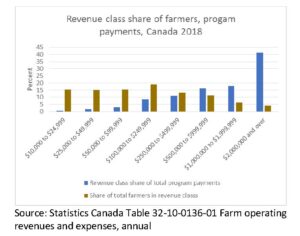National Farmers Union Submission in Advance of the 2021 Federal Budget
The first-ever Food Policy for Canada was announced in 2019 following an in-depth consultation process that engaged tens of thousands of Canadians over two years. It is a platform for collaborative work by governments and civil society organizations working towards a food system that is resilient, diverse, and abundant. Its vision is “All people in Canada are able to access a sufficient amount of safe, nutritious, and culturally diverse food. Canada’s food system is resilient and innovative, sustains our environment and supports our economy.”
The COVID 19 pandemic is providing a real-life stress test for our food system, revealing gaps and weaknesses as well as strengths and resilience, highlighting both needs and opportunities that require funding in Budget 2021.
Global uncertainty, particularly in regard to Canada’s largest trading partner’s ability to manage the pandemic, will undoubtedly affect food availability and prices for consumers, jobs and wages for food sector workers, and our farmers’ incomes. The pandemic’s most dramatic immediate impact was on three major sectors of Canada’s food and agriculture: labour-intensive farms, livestock/meat, and local food. Knock-on effects of COVID-related economic challenges for buyers and consumers may have adverse impacts on grain and oilseed producers.
It is certain that Canadians need to eat every day, and that our agricultural land base can provide abundant food for domestic consumption as well as for customers in our export markets. It can only do this in accordance with the Food Policy for Canada’s vision if the necessary structures and systems are built and maintained. In contrast to the five-year allocation of $134 million to implement the Food Policy for Canada, the Canadian Agriculture Partnership was budgeted $3 billion over five years in Budget 2019. Budget 2021 can redress this imbalance by aligning CAP funding with the Food Policy vision.
We commend the government for rapidly rolling out measures to address both health and economic needs of Canadian residents during the pandemic. We are also in the midst of a longer, but more serious and far-reaching crisis: global climate change. Budget 2021 must fund specific measures to address the climate crisis as it affects and is affected by Canadian agriculture, and also apply a climate-change filter to all budgetary measures to avoid perverse incentives and gaps that would accelerate global warming.
The third crisis – long-term net farm income decline — continues to drive farmers off the land, force farm families to rely on off-farm income for survival, and promote absentee-ownership. Budget 2021 must also ensure it increases the number of farmers, especially those who are Indigenous, Black, People of Colour, young and/or female, and promotes reliable, viable farm incomes so they can achieve long-term success. Fixing the farm income problem and reducing farm debt will allow farmers to make investments and change management strategies so they become less vulnerable to climate impacts, pandemics and other crises.
All three crises can be addressed through public investment in domestic food production and processing capacity, by thoroughly revamping the Business Risk Management (BRM) programs to provide relevant and equitable safety nets for farmers of all sizes and types, and by refocusing Canadian Agriculture Partnership (CAP) strategic investment streams to support transition to a food system that delivers sustainable farmer livelihoods, consumer health, environmental sustainability, rural prosperity, and food sector employment in alignment with climate mitigation and adaptation.
Building Domestic Market Capacity
As soon as lock-down measures were announced, farmers experienced a dramatic surge in demand for local products. Farmers markets were soon declared essential services. Many farmers set up on-line ordering and delivery/pick-up systems to continue serving their customers. Farmers were faced with decisions about scaling up production not knowing whether the uptick in demand would continue. Now, it appears that consumers are committed to buying more Canadian food. Consumers’ responses to the recall of imported red onions contaminated with salmonella underlines the desire to buy Canadian and support Canadian farmers. Similarly, preventable illnesses and deaths among Temporary Foreign Workers in the major meat packing plants and on farms, combined with the wastage of produce due to lack of sufficient labour to harvest perishable crops, highlights the urgency to improve our system.
Budget 2021 should thus expand production, processing and distribution capacity to serve the domestic market. If one-third of Canada’s food imports were produced domestically, $15 billion food dollars would be able to foster economic diversification and rural revitalization via safe, nutritious, and culturally diverse food produced by a much larger number of Canadian farmers.
Budget 2021 should increase Canada’s Food Policy implementation funds and re-allocate CAP Strategic Investment funds and targeted provincially cost-shared funds to:
- Increase both the numbers and capacity of local and regional abattoirs by
– providing transition funds to owners and prospective owners,
– expediting scale-appropriate food safety regulations,
– training more butchers and inspectors,
– fast-tracking the re-licensing of recently closed abattoirs, and
– encouraging multi-species facilities which will facilitate diversity of livestock production. - Expand the capacity of local food institutions to provide aggregated processing, storage and distribution facilities for the benefit of smaller scale producers. Eligible recipients should include both established and newly founded community-based multi-stakeholder co-operatives, food hubs, farmers markets, and producer associations. The funds allocated in 2019 for this purpose under the Local Food Infrastructure Fund are insufficient to meet the need, with first-round applications exceeding the five-year total allocation.
- Reform the Temporary Foreign Worker programs and enforce compliance with rules to ensure workers are guaranteed safe working and living conditions, the ability to change employers and speak up without fear of deportation, and are eligible for permanent resident status on arrival.
- Invest in resident Canadian agricultural workforce development so farms are less reliant on workers from abroad. Colleges, courses and training opportunities need to be supported and rebuilt to provide more employment opportunities for youth who wish to work on farms.
AgriStability
 The graph to the right shows how the largest farms disproportionately benefit from program payments such as AgriStability. Only 4.1 percent of Canada’s farms are in the over $2 million/year annual revenue class, yet they received 41.4% of program payment dollars in 2018. 60% of program payments went to under 11% of farms, while the $100,000 to $250,000 revenue class with the most farmers, comprising 28,935 farms or 13% of farms, received just over 11% of program payments.
The graph to the right shows how the largest farms disproportionately benefit from program payments such as AgriStability. Only 4.1 percent of Canada’s farms are in the over $2 million/year annual revenue class, yet they received 41.4% of program payment dollars in 2018. 60% of program payments went to under 11% of farms, while the $100,000 to $250,000 revenue class with the most farmers, comprising 28,935 farms or 13% of farms, received just over 11% of program payments.
Budget 20201 must revamp the AgriStability framework by returning to the 15% margin loss trigger and removing the reference margin cap, which limits payouts based on eligible expenses. The current program is used by less than 1/3 of Canadian farmers, and it is of no value to farmers using climate-friendly low-input and/or mixed farming strategies. As such, this program is not only unfair, but is a perverse incentive in terms of both climate impacts and farmer numbers.
Supply Management
At the onset of the pandemic, our supply managed sectors were dealt a shock to their distribution and processing systems when retail demand surged and products packaged for restaurant use virtually disappeared. The pandemic’s impact on our producers was much less severe than in countries without supply management, such as the USA and the UK. Our dairy, egg and poultry sectors are well organized and coordinated, and were able to rapidly adjust and share the burden of costs and losses equitably. The supply management system is a resilient, democratically controlled institution that provides food security to Canadians while delivering viable farm incomes and retaining billions of food dollars within our economy. Recent trade agreements – CETA, the CPTPP and the CUSMA – have together take 18% of the domestic market from our supply managed farmers and increased their costs of production.
Budget 2021 must ensure the design of compensation packages prioritizes increasing the number of dairy, egg and poultry farmers earning viable incomes providing food to Canadian residents. The federal government must commit to no further erosion of supply management in future trade deals, and take every opportunity to regain domestic market share for our supply managed sectors.
Climate Change
The rapidly unfolding climate crisis is causing increasing hardship, uncertainty and destruction. Its impacts on farming and food production across Canada affect the entire economy. Agriculture presents both problems and opportunities: changing how we farm can reduce GHG emissions, improve farm incomes and reduce the frequency and intensity of disasters that require recovery funds. Investing in climate solutions is a prudent budgetary measure. The complexity, urgency and significance of climate measures requires a large-scale response grounded in both scientific research and public interest values.
Budget 2021 should provide funding to develop and coordinate research in support of climate-friendly, low-input production at AAFC research stations, universities. Budget 2021 should also provide tax incentives and program funding designed to promote increased on-farm farm diversity through extended crop rotations, planned grazing of livestock, reduced inputs, soil-building, wetland conservation, and on-farm processing. The climate adaptation benefits that will result will stabilize farm incomes and reduce insurance payouts, reducing the net cost of these budget initiatives while increasing rural prosperity. To maximize the impact of these measures, Budget 2021 should establish an effective, national agriculture extension program to help farmers learn how to help meet Canada’s greenhouse gas reduction targets.
Recommendations:
1. That the government provide a capital funding program of at least $125 M per year to increase local and regional abattoirs numbers and capacity.
2. That the government allocate at least $75M per year to the Local Food Infrastructure Fund and expand its eligibility criteria to include both established and new organizations.
3. That the government reform the Temporary Foreign Worker programs to ensure all workers have safe working and living conditions, the ability to change employers and speak up without fear of deportation, and are eligible for permanent resident status on arrival.
4. That the government provide $5M for mandatory annual inspection and enforcement of TFW regulations across Canada.
5. That the government invest $15M in training programs and facilities to develop the resident Canadian agricultural workforce.
6. That the government provide $150M annually to establish and operate a national agriculture extension program to help farmers meet greenhouse gas reduction targets.
7. That the government revamp AgriStability by returning to the 15% margin loss trigger and removing the reference margin cap.
8. That the government establish criteria for the previously announced $1.75 B CETA compensation package to ensure it results in more supply-managed farms producing dairy for Canadian consumption.
All of this respectfully submitted by
The National Farmers Union
August, 2020
